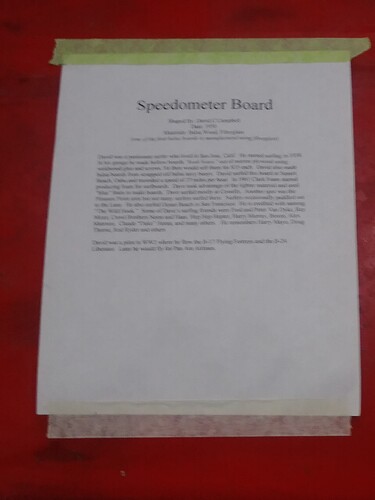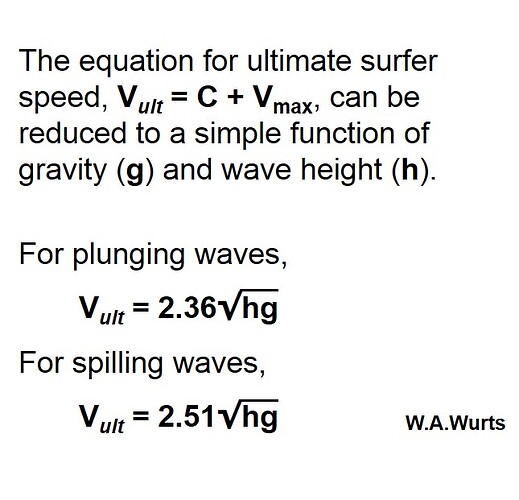Larry Goddard asked if I could post his reply:
I’m happy and thrilled that somebody else decided to analyze the question of wave speed and surfboard speed. It is not as straightforward a problem in Physics as some people might think.You want to calculate how fast the surfboard CAN or MUST go to stay just ahead of the breaking wave.
First, the analyst must make a few Assumptions (known mathematically as ‘Prior Conditions’). Then, from that starting point, you only need a knowledge of wave dynamics and Physics, plus some first-year Algebra, to derive a Mathematical Model for finding the Surfer Speed, given the ACTUAL or TRUE Wave Height and the Peel Angle.
The TRUE height of anything means ‘Top-to-Bottom’, so that INCLUDES the unrideable portion of the wave that we call the TROUGH. It’s below sea level, and the wave face is not steep enough down there to keep your board moving. After all, the board is sliding downhill, so If you go TOO low on a wave, your board will start to mush out and eventually will STALL. You want to calculate how fast the surfboard CAN or MUST go in order to stay just ahead of the breaking wave. Note that if you are riding a ‘Head High’ wave, your board is still about a foot or more ABOVE the bottom of the wave. If it LOOKS LIKE 5 feet (from the deck of your your surfboard to the top of the wave) , the TRUE height is actually about 6 to 6.25 feet.
You must use the TRUE height of the wave in my Surfer Speed model.
My model says that (for a Spilling wave, at least), you can go AS FAST in MPH, as 7 times the Square Root of the True Height, in feet, for a maximum Peel Angle of 53 degrees from Straight-Off. In GIANT surf, the maximum ‘make-able’ wave peel angle will be much less.
4 ft = 14 MPH
9 ft = 21 MPH
16 ft = 28 MPH
25 ft = 35 MPH (looks like 20 ft at Waimea Bay)
36 ft = 42 MPH (looks like 30 ft at Waimea Bay)
49 ft = 49 MPH
but,
100 ft = 70 MPH! (The peel angle at Nazare in Portugal is much lees than Makaha Point Break.
My model shows that the HIGHER you can get on a wave, (before it goes vertical), the STEEPER the wave face surface is, and the FASTER you can go! This works best for Spilling-type, fast-breaking long walls like Point Breaks. If you are approaching a fast section up ahead, and want to get around it, you need to climb HIGHER on the wave face so you can then dive lower going thru that section. You EXCHANGE Altitude (Potential Energy) for Speed (Kinetic Energy). Your Total Energy while riding on a wave is the SUM of Potential Energy and Kinetic Energy.
BUT, If you wish to position yourself INSIDE the Tube, you must ride well down on the face of a Plunging-Type Wave, where the wave face is not as STEEP. And LESS steep means you go SLOWER! So, you might even need to slow the board down a bit to match the speed of the tube. That’s all right: It’s pretty exciting inside the ‘Green Room’!
Surfers who use so-called “LOCAL Scale”, which is based on the old ‘Hawaiian Scale’ from the 1950s and 1960s, should be aware that the old U.S. Weather Bureau used METRIC, only expressed in “HALF-Meters” rather than METERS. So, a Half meter is about half of 39.37", or about 19.685 inches. If you round that up slightly to simply 20 inches, then a wave that looks like ‘5 feet’ (or 60") is "3 Half-meters, Hawaiian Scale (NOT FEET!). The True Height might be 6 feet, so the Hawaiian Scale is about 1/2 of the True Height, if you include the Trough.
Bob, few surfers have the patience to read my original treatment of “Surfer Speed vs.Wave Height”, so if you want to send the above to Swaylocks, I’d much appreciate it.

